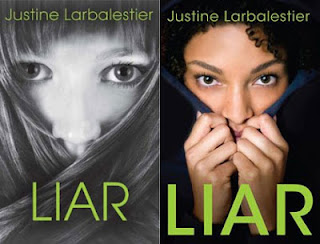A few years ago the children’s book world learned a new word, or a new use for an old one: whitewashing.
Whitewashing is the term used for the practice of putting a white model on the jacket of a book about a black or other non-white protagonist, in the presumed hope of not "putting off" potential white readers. As one striking and well-known instance, let’s take the case of Justine Larbalestier’s 2009 novel, Liar. The heroine of Liar, Micah, is biracial, and described as having “nappy” hair; but advance copies of Bloomsbury’s US edition showed her as a white girl with straight hair – a move that drew such loud protests (including from Larbalestier herself) that the publisher hastily replaced the cover with one more representative of the book’s contents, as this before-and-after picture shows:
Whitewashing is the term used for the practice of putting a white model on the jacket of a book about a black or other non-white protagonist, in the presumed hope of not "putting off" potential white readers. As one striking and well-known instance, let’s take the case of Justine Larbalestier’s 2009 novel, Liar. The heroine of Liar, Micah, is biracial, and described as having “nappy” hair; but advance copies of Bloomsbury’s US edition showed her as a white girl with straight hair – a move that drew such loud protests (including from Larbalestier herself) that the publisher hastily replaced the cover with one more representative of the book’s contents, as this before-and-after picture shows:
The case of Liar is far from isolated, and you can read a recent article about the whitewashing phenomenon, with many more examples, here. The problem isn’t confined to race, however. More recently, an edition of Anne of Green Gables drew the wrath of many by its portrayal of the red-headed Anne Shirley (whose hair colour is a major plot point) as blonde:
Why did the publishers of this edition give us a blonde Anne? Was it because they believe blondes sell more books than redheads? Was it a fiendish attempt to gain notoriety on the internet, on the principle that there’s no such thing as bad publicity? Possibly, possibly, although in this case another factor may have been lack of a design budget and ignorance of the book’s content: the offending edition of Anne was self-published, and self-publishing (for all its virtues) has in some cases made badly-designed jackets a new art form.
So far we’ve had whitewashing and blonde-washing – but there are other wash cycles out there, and not only for jackets. There’s straight-washing, for example. This goes back a long way: as early as 1640 John Benson published an edition of Shakespeare's sonnets with the pronouns changed to make them look as if they were all addressed to a woman. A mere 371 years later, Sherwood Smith and Rachel Manija Brown’s YA novel Stranger was taken on by a major agent, but only on condition that one of the main characters, who happened to be gay, was made straight. In a book market where LGBT people, like black people, are woefully underrepresented compared to their numbers in the real world, especially as protagonists or major characters, this attempt to suppress their appearance was seen by many as pernicious – for society as a whole, but particularly for young LGBT readers.
Being behind the times, I discovered only recently the extent to which some popular Japanese anime cartoons have been straight-washed in the process of being adapted for American viewers. In Japanese manga (comics) and the children’s anime that are based on them, romantic feelings between people of the same sex are frequent, and not generally seen as problematic. For example, in the manga Cardcaptor Sakuraand in the anime of the same name, ten-year-old Sakura (female) has a crush on her older brother’s friend, Yukito (male) – but so does her classmate, a boy named Li. In addition, Sakura’s own female best friend, Tomoyo, is in love with her. When the anime was adapted for American television under the name Cardcaptors, Sakura’s crush on Yukito (now called Julian) was preserved, but Li’s was erased; and Tomoyo’s (now Madison’s) love for Sakura was transformed into non-romantic friendship. So integral were both these threads to the original story that the American censors had to go to great lengths to achieve the change, deleting many scenes in the process (and filling the gaps with irrelevant flashbacks to previous episodes), while making innumerable smaller cuts and changes to dialogue. Even so, Cardcaptors still retains traces of what has been ripped from it, in the form of inexplicable blushes and plot lines that no longer quite make sense. These were a sacrifice apparently seen as worth making on the altar of heteronormativity. Cardcaptor Sakura is not a unique case, either: the adaptors of the anime Sailor Moon went so far as to change the sex of one of the characters (Zoisite) in the English version, so as to render him (now her) acceptably straight.
Are things getting better, or worse? It's hard to say. The story of Sherwood Smith's and Rachel Manija Brown’s rejection provoked understandable outrage, and perhaps as a result appears to have acquired a happy ending: their book is now after all to be published as written. As for anime, the examples I've cited are over a decade old, and I'm told by people more knowledgeable than I that there haven't been any recent cases of straight-washed English-language versions of Japanese anime. That doesn't mean that same-sex romance has found its way onto English-speaking children's cartoons, however. If we wish to increase the representation of LGBT characters, perhaps that's not such a huge amount of progress, after all? Meanwhile, cases of whitewashing (and its variants) continue to crop up regularly; girls are featured less prominently on book jackets than boys (even when equally prominent in the story); fat characters are portrayed as thin - and so on, and on. Editorial and marketing decisions will always tend to drift in the direction of safety and perceived "norms". If that's to change, it's up to writers and readers to pull hard in the other direction.
3 Comments on Wash and Spin - Cathy Butler, last added: 3/13/2013
Display Comments
Add a Comment






Thanks for flagging these up, Cathy - at a time of what feels like constant compromise, some battles are still worth fighting!
To be honest, I'm surprised that characters of ten were allowed even a heterosexual crush. My experience of books that publishers want to sell into the American market is that no sexual content at all is really acceptable - at least not if they hope to get it into a school library.
Some of the errors just fall under the category of stupidity - or of cover-designers not reading the book. The Anne of GG, for instance, is probably not an anti-readhead choice. There are as many books in which the dog or horse on the cover is the wrong colour/breed, or the landscape shows the wrong country, etc.
I agree with you, regarding white-washing particularly, but I do think there is also a large margin of gross incompetence in some of the other examples rather than 100% iniquitous malice.
You know American publishers better than I do, Stroppy, but I should have made it clear that in talking about a crush and romantic feelings I don't mean "sexual content" in any explicit sense. At least, no more than would be implied by a ten-year-old swooning over Justin Bieber, which I find it hard to believe would be considered beyond the pale.